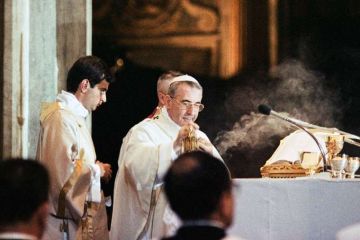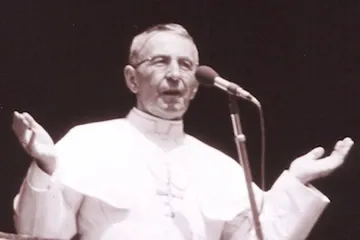Denver Newsroom, Sep 2, 2022 / 08:00 am
Venerable John Paul I was born Albino Luciani on Oct. 17, 1912 in the town of Canale d'Argordo in northern Italy’s Belluno province. He was the most recent pope to be born in Italy and the first pope to be born in the twentieth century.
He was elected to the papacy on Aug. 26, 1978. He would be dead just a month later. Though his time as Roman Pontiff was brief, he had such an impact that some Catholics have sought his intercession as a saint. The Vatican has recognized a miraculous healing attributed to the first Pope John Paul and he will be beatified this Sunday.
Here’s more to know:
John Paul I was known as the "Smiling Pope"
The photogenic smile of the pope helped cement his reputation and his nickname.
His reputation echoed his pastoral style: he drew praise for his ability to be close to ordinary people. He could present Christianity and Catholic teaching in a way that was accessible.
For example, he spoke to Italy’s children before their first day of school in remarks after the Sunday Angelus on Sept 17.
For them, he invoked the example of the folk tale figure Pinocchio: “not the boy who one day skipped school to go and see puppets; but that other boy, Pinocchio who took a liking to school. So much so that during the entire school year, every day, in class, he was the first to enter and the last to leave.”
The pope admitted he hadn’t learned how to be a good bishop. But he promised to try.
When a massive congregation gathered in St. Peter’s Square for his inaugural Mass as Pope, he pledged a spirit of service.
“Let all here, great or small, be assured of our readiness to serve them according to the Spirit of the Lord,” he said.
He approached being pope with humility. In a Sept. 23 homily at the Archbasilica of Saint John Lateran, he said: “Although already for twenty years I have been Bishop at Vittorio Veneto and at Venice, I admit that I have not yet ‘learned the job’ well.”
“It is God’s law that one cannot do good to anyone if one does not first of all wish him well… I can assure you that I love you, that I desire only to enter into your service and to place the poor powers that I have, however little they are, at the disposal of all.”
A Pope with two names? Why he chose ‘John Paul’
He was the first pope to take two names. “John” and “Paul” honored his two immediate predecessors, Popes John XXIII and Paul VI.
John XXIII, the former Patriarch of Venice, had made him a bishop. Paul VI had named him the Patriarch of Venice and a cardinal.
(Story continues below)
Luciani explained why he chose to be the first “Pope John Paul” in his Sunday Angelus remarks at St. Peter’s Square on Aug. 27, the day after he was elected Roman Pontiff:
“Pope John had decided to consecrate me himself in St. Peter’s Basilica. Then, however unworthy, I succeeded him in Venice on the Chair of St. Mark, in that Venice which is still full of Pope John. He is remembered by the gondoliers, the Sisters, everyone.”
“Then Pope Paul not only made me a cardinal, but some months earlier, on the wide footbridge in St Mark’s Square, he made me blush to the roots of my hair in the presence of 20,000 people, because he removed his stole and placed it on my shoulders,” he continued. “Never have I blushed so much!”
Pope Paul VI was pope for 15 years. Pope John Paul said that his predecessor showed “not only to me but to the whole world, how to love, how to serve, how to labor and to suffer for the Church of Christ.”
“I have neither the ‘wisdom of the heart’ of Pope John, nor the preparation and culture of Pope Paul, but I am in their place,” he told those gathered for the Angelus. “I must seek to serve the Church. I hope that you will help me with your prayers.”
The day before he died, he explained a prayer his mother taught him
Though he didn’t know it, John Paul’s Sept. 27 general audience was his last. He reflected on a prayer taught him by his mother.
“My God, with all my heart above all things I love You, infinite good and our eternal happiness, and for your sake I love my neighbor as myself and forgive offenses received,” the prayer said. “Oh Lord, may I love you more and more.”
“This is a very well-known prayer, embellished with biblical phrases,” the pope commented. “My mother taught it to me. I recite it several times a day even now, and I will try to explain it to you, word by word, as a parish catechist would do.”
Reflecting on the prayer’s last words, “Lord, may I love you more and more,” John Paul I explained that we should love God “so much.” We must not stop at our current point, “but with his help, progress in love.”
Shortest pontificate ever? No, but close.
John Paul I was pope for 33 days, from Aug. 26 to Sept. 28, 1978. His 33-day pontificate was the 10th shortest. The last pope to have such a brief pontificate was Leo XI, whose pontificate lasted 27 days in April 1605.
A shocking death
The death of a pope so soon after his election caused such great shock that it continues to attract attention.
Vatican reporter Stefania Falasca’s 2017 book “John Paul I: The Chronicle of a Death” is a recent effort that thoroughly discusses his last days. Her work draws on medical reports, witness testimonies, and Vatican documents.
She recounts that the evening before his death, the pope suffered a severe pain in his chest for about five minutes, a symptom of a heart problem. This took place before dinner while he was praying Vespers with his Irish secretary, Monsignor John Magee.
When the pain subsided, the pope rejected the suggestion to call for a doctor. Renato Buzzonetti, his doctor, was only informed of this episode after the pope died.
The specific cause of his death will likely never be ascertained with certainty because no autopsy was performed, in keeping with Vatican protocol. Bishop Enrico Dal Covolo, the former postulator for John Paul I's sainthood cause, has said medical records collected as part of the process also support the conclusion that the pope died of natural causes.
There are various rumors about John Paul’s death, including sensational speculations about an assassination plot by nefarious groups with an interest in the Vatican’s role in religion, politics, or finance.
John Paul I wrote “open letters” to Mark Twain, Pinocchio, and King David
His 1976 book Illustrissimi is a collection of imaginative fiction: “open letters” to historic figures, saints, famous writers and imaginary characters. Some are playful in style, while others engage in social commentary, personal advice, or spiritual reflection.
Several are matters of religious devotion. One collection of these letters closes with John Paul’s letter he wrote “with trepidation” to Christ.
“With You I try to maintain a constant conversation. But to translate it into letters is difficult: these are personal things… And besides, what can I write to You, about You, after all the books that have been written on You?” the letter said.
Expressing dissatisfaction with his open letter to Christ, the future pope concluded: “the important thing is not that one person should write about Christ, but that many should love and imitate Christ.”
He was never a pastor of a parish church
Despite his “pastoral” reputation, the future John Paul I never served as a pastor leading a parish! He was a curate for his hometown church in Canale d'Agordo only for the six months after his ordination in July 1935. During his life, he was a seminary professor and seminary rector. He held several leading roles in the chancery of the Diocese of Belluno e Feltre before he was named Bishop of Vittorio Veneto in northern Italy. From there, he would become Patriarch of Venice, cardinal, and pope.
His beatification miracle happened in Argentina
Candela Giarda, an 11-year-old girl from Paraná in northeastern Argentina, suffered brain dysfunction and septic shock amid uncontrollable seizures. She was later diagnosed with Febrile Infection-Related Epilepsy Syndrome.
The girl’s mother, Roxana Sosa, went to pray in the Catholic church next to the Buenos Aires hospital and met a priest, Father José Dabusti.
Candela’s health became worse and worse, a Vatican investigation later reported.
On July 22, 2011, doctors said Candela was facing “imminent death,” When Dabusti came to pray with the girl’s mother, he suggested they pray for healing through the intercession of John Paul I.
Though Sosa did not know much about the deceased pope, she prayed to him exclusively. The priest and the nursing staff of the intensive care unit joined their prayers to hers.
Candela showed improvement overnight. Two weeks later, her doctors removed her breathing tube. Her epilepsy was cured a month later, and she was discharged from the hospital on Sept. 5.
The young girl is now a young woman in her early 20s. As of last year, she was pursuing veterinary studies.
Dabusti reported the apparent miracle to Vatican officials and followed their instructions to record everything that had happened.
By coincidence, the Archbishop of Buenos Aires at the time was Cardinal Jorge Mario Bergoglio, the future Pope Francis. After the proper investigation by Church officials, Francis on Oct. 21, 2021 recognized Pope John Paul’s miracle.






